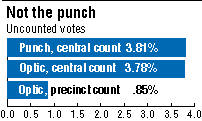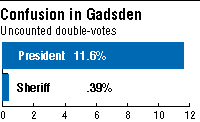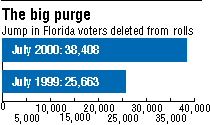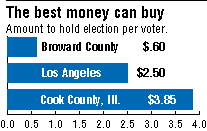Sunday,
December 17, 2000, updated at 11:38PM
Big Lie: Every vote countsBy Paige St. JohnDEMOCRAT STAFF WRITER For seven hours on a cloudy Tallahassee morning, local judges and dozens of anonymous court clerks were sequestered in a conference room of the Leon County Public Library with the sacrosanct ballots of Miami-Dade County's 9,000 uncounted undervotes. Through magnifying glasses they peered at punch cards for the telltale pinholes of light and truth that meant a vote. They were almost halfway through when the U.S. Supreme Court halted the effort. Four days later, Vice President Al Gore conceded. With a 537-vote margin, Texas Gov. George Bush took Florida's 25 Electoral College votes, enough to win the presidency. Because of those uncounted ballots, however, the world might never know: Who really won? Elections, mathematician C.L. Dodgson (aka Lewis Carroll) wrote in 1876, are not truth. Rather, Dodgson said, they should be considered "more as a game of skill than a real test of the wishes of the electors." In other words: There may be a legal number, but there is no True Number. Not every vote counts. "Most Americans believe, like the tooth fairy and Santa Claus, that elections are fair and honest and they sort of just happen," said elections systems examiner Michael Shamos, a computer programming specialist and director of Carnegie Mellon University's Universal Library. "When you look up close, it's a tremendously flawed system." Shamos has studied an estimated 170 voting systems. He panned the popular punch card in 1980 as "not only the worst system we had ever seen but the worst one we could conceive of." He believes every one of the three voting systems used in Florida (punch card, optic scan and paper ballot) cannot say to a single vote what every voter intended. It is a difficult fact to accept. A consortium of major newspapers and news outlets is pressing its legal right to retrieve the thousands of uncounted ballots for recounting. If they prevail in court, they'll then have to decide what mark makes a vote -- a dimple, a dent, a dent with a circle. But what about the 19,000 double-votes that spoiled ballots in West Palm Beach County? And the migration of thousands of unexpected votes to Reform Party candidate Pat Buchanan on that county's butterfly ballot? And more than 2,000 similarly overvoted ballots in Gadsden County? What about those who might have voted? The Seminole County Democrats whose absentee ballot requests were thrown out while their Republican counterparts were helped in? The reports of intimidation at polling places and voters illegally turned away because they didn't have photo IDs? Shamos warns that any post-election recount effort on a voting system that has displayed such a large margin of error is as futile as Jonathan Swift's Lilliputian war between the Big-Endians and the Little-Endians over which is the correct side to crack a soft-boiled egg. Numbers experts agree. Both Bush and Gore left Florida with 48.8 percent of the vote. "Once you get to something statistically this close, it looks an awful lot like a tie," said Lorrie Faith CranorÊf+zÊÊf-zÊ, an engineering and policy researcher at AT&T Labs in New Jersey who studies electronic voting. "Flip a coin and forget it. That's the sort of thing your average person finds really disconcerting, but to a statistician, that's actually more comforting." And more real. Why? There were 178,185 uncounted presidential ballots in Florida, just shy of 3 percent of the nearly 6 million votes cast and more than the population of Tallahassee. An unknown number were left intentionally blank. An unknown number were intentionally spoiled by voting twice -- overvoting. And another unknown number were missed by the optical scanner, or miscast by confused voters, or mangled by the counting machine.
In the Florida chaos, electoral and media sources attacked long-known flaws of the punch card voting system with fury. The punch card originally was developed to feed IBM computers, not to vote by human hand. They allow some voters to cast too many votes. Worse, they allow otherwise good votes to go uncounted if the bit of paper being punched out flips back into the hole. Recounts on punch card systems are notorious for never producing the same number twice, as more and more of those paper pieces, called chads, fall off. A New York Times analysis damned the punch card for allowing 1.5 percent of the Florida vote to register as zeroes, compared to .3 percent of ballots cast on optic scan systems. The finding, suggesting there were valid votes hidden among dangling chads, made its way into the dissenting pro-recount opinion of U.S. Supreme Court Justice Stephen Breyer. But it didn't mean punch cards are worse overall. The Times had lumped together two very different optic scan setups, and focused only on one possible error, undervotes. In reality, Florida voting results show, when it came to producing countable votes, the punch card has an equally bad counterpart in the optic scan system, when those votes are counted at a central location instead of at precincts. Optical scan ballots work like high school exams -- paper forms with bubbles to be filled in by hand. In 16 Florida counties, the voting process stops there. Good or bad, the ballots are dropped into a box and trucked to a central spot for counting after the polls close. But in 22 other Florida counties, including Leon, the filled-in ballots are fed into a counter at the precinct. Bad ballots are spit back and the voter gets a second, even a third, chance to try again. Running a punch card through the same kind of precinct counter could "lessen the problems inherent in the punch card system," said Herb Asher at Ohio State University's John Glenn Institute for Public Service and Public Policy. Asher helped publicize some of the earliest work condemning the punch card as error-prone 22 years ago, and finally the system appears doomed. Abandoning punch cards for optic scan systems without at the same time demanding precinct counting, Asher said, "may be going from the frying pay into the fire."
What went wrong? "I don't know," said Elections Supervisor Denny Hutchinson. "I think there were too many presidential candidates." Gadsden County is rural. It is poor. Forty percent of the adults did not finish high school. Election observers suggested that illiteracy was the problem. However, in past elections, the double-voting rate was half that of this year. And other races this year had a fraction of the presidential throw-out rate. But in the presidential race, eight candidates were printed in one column. In the next column, under "General Election," appeared names of two more obscure presidential candidates, Howard Phillips and Monica Moorehead. Ohio State University's Asher last week tried out the Gadsden ballot on a breakfast meeting of the Columbus Rotary Club, with instructions for the business members to pick one candidate in every race. The Rotarians made the same double-vote mistakes, picking a candidate in each column. What's more, four other Florida counties with the same two-column presidential race had high rates of overvoting -- from 5 percent of Gulf County to 8.5 percent in Franklin County.ÊGRFK NO Vote, No CountÊÊu=B67602D7Ê` West Palm Beach's confusing butterfly ballot, with candidate names in two columns and the vote punches running down the middle, showed no voter is immune to hard-to-understand ballots. Voters of all ages and backgrounds complained they had difficulty. But Asher's research on elections in Ohio showed ballot design errors tend to mostly affect voters who have lower incomes and less education. With the exception of one precinct, Gadsden County's own results also showed the double-voting rate increased as the precinct's black registration rate increased. To Asher, that means voters were not given the information they needed. "I get really angry when I hear, 'They're stupid, it serves them right,' " Asher said. "I think that's the wrong attitude. You want to encourage participation to complete votes." More so than the kind of the machine being voted on, an understandable ballot is key to casting votes that count, usability experts say. "The system is so imperfect, it disenfranchises many voters," said Susan King Roth, chairwoman of the Department of Industrial, Interior, and Visual Communication Design at Ohio State University. Roth has studied the effects of ballot designs on voting behavior. "People don't operate like expert users," she said. "The fact that there are so many systems out there that don't discourage human error means we haven't gotten there yet."
After scandals of vote-buying, dead voters and felon voters in Miami two years ago, Florida began a campaign to clean its voter registration rolls. The Secretary of State's Office hired a computer company to produce a list of suspected invalid voters, including convicted felons, and sent the names to election supervisors. The purge list was bad -- containing thousands of names of properly registered voters. Some, like Leon County, refused to use it. Some, like Gadsden County, used the list to send out notices of removal. The effect was that in July 2000, Florida election supervisors deleted 38,408 voters, half again as many as were removed in July 1999. No one knows yet how many properly registered voters were dumped, but Leon County Elections Supervisor Ion Sancho said only 34 of 690 voters targeted for removal proved to be felons. Another challenge was faced by overseas absentee voters, who have added burdens of requesting their ballots. "As a first-time voter, unsure of all the absentee voting ins and outs at the time I left to study abroad, the process seems tedious and too difficult for the non-zealous voter to complete willingly," said Melissa Renwick, a Tallahassee woman living in Italy. Her ballot arrived at Leon County in time to be counted, but without the prior request. It was thrown out. But even those who followed the rules found themselves without a vote. As a last-ditch effort, the commander of a U.S. Navy ship stationed overseas in November pleaded to Secretary of State Katherine Harris for help in finding his AWOL ballot.
They must present a clear and unconfusing slate of candidates; allow voters to clearly express their intent; allow the ballots to be transported to a counting system without possibility for tampering; and count the votes correctly. The punch card system Shamos examined in 1980 failed on all four counts. But, he said this week, so does the optic scan system. And so does the old-fashioned paper ballot -- still used in 410 counties in the United States, including one in Florida. Shamos has only seen four voting systems he thinks will work -- all direct entry voting computers. Flashing lights on the machines allow voters to see whom they are voting for. Program codes prevent overvoting. A paper printout keeps a tally for potential recounts and court challenges. And the machines are immune from at least old-fashioned vote tampering methods -- punches made by belt buckle prongs and marks added by bits of pencil lead beneath fingernails. But this year in Trenton, N.J., one direct entry voting computer improbably showed no votes for two local candidates' running mates. "The computerized machines are not so flawless," said Rebecca Mercuri, president of Notable Software Inc. and a professor of computer-related risks at Bryn Mawr College in Philadelphia. Mercuri argues that she believes the electronic voting machines cannot be audited, paper printouts notwithstanding. "I can teach my first-year students how to show one thing on the screen, print something else on the paper tape, and record something different on the computer disk," Mercuri said. "It's sort of scary, because a lot of places want to throw out these punch cards and switch to something really scary. "People keep flinging around words like, 'If we had modern computers and new technology we should change things.' In fact, that is not the case because there really is no regulation on these types of machines. And very few municipalities have either the funding or the knowledge to assess these pieces of equipment." Another threat to democracy lurks in the shadows -- civil rights violations. "Collectively, it is all very troubling, when you look at the widespread, outright, ignoring or violation of the law," said Randall Marshall, legal director for the Florida American Civil Liberties Union. "Just take, for example, the numerous, credible stories of people who were turned away because they didn't have a photo ID." Even machine error, on the scale seen in Florida, is a contributor, Marshall said. "It became clearer and clearer that elections officials have known for years of the problems, yet have not acted, to put it generously, or to put it another way, intentionally failed to act." The ACLU, Florida Justice Institute and Florida Legal Services sponsored a voting rights conference last week to strategize on what to do. Whatever happens, Marshall said, "it will probably involve litigation." "Without being cynical, there is a certain level of a kind of voter fraud, if you will, and irregularities that everybody has known exists," he said. "It took this kind of an absolute close race in a presidential election to shake everybody up. "At the beginning, you saw a certain sense of, 'Wow, my vote really does count!' But now?" A new American distrust is the worry of elections experts such as Doug Lewis, director of the Election Center in Texas, the national organization that trains election supervisors and helps evaluate election equipment. "No one has seen all these warts before," Lewis said. "I don't think the people in Florida, nor the elections administrators, ought to hang their heads. . . . I think cool, calm reflection will reveal that in most instances, most things in Florida were done pretty well." Lewis points to the close national elections of 1824, 1876 and 1888. "I'm sure that they were thinking at that time things were broke, too," he said. "But elections have become better and better and better." And there are still voters like Vivian Kelly, an 81-year-old civil rights activist in Gadsden County. She has registered voters in Gadsden County for four decades. She has seen flaws more serious than even those shown this year. But Kelly is not cynical. "I tell you, when I was in 11th grade I had a home economics teacher named Miss Jackson. She was saying, when you get registered and vote for things, you can get what you want," Kelly said. Gadsden County, though Florida's only majority black county, has had a historically difficult time electing black officeholders. The new exposure to faults in the system do not deter Kelly's belief that, even though every vote does not get counted, indeed, every vote does count. "See, I know what is right. I know what can make people great." Contact Paige St. John at pstjohn@taldem.com
or (850) 599-2305.
|



